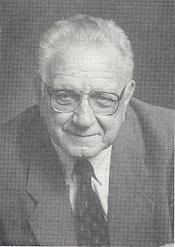Residence U.S. Role Economist Nationality American | Name Arnold Harberger | |
 | ||
Doctoral students Gregory ChowRobert Lucas, Jr.Zvi GrilichesMarc NerloveSebastian Edwards Books Project Evaluation: Collected Papers Awards Guggenheim Fellowship for Social Sciences, US & Canada Similar People | ||
A conversation with arnold harberger
Arnold Carl Harberger (born July 27, 1924) is an American economist. Harberger's triangle, the deadweight loss that is caused by government regulation, is named after him.
Contents
Arnold harberger 1ra parte
Life
Harberger completed his B.A. in economics at Johns Hopkins University, and his M.A. in international relations in 1947 and his Ph.D. in economics in 1950, both at the University of Chicago. After teaching at Johns Hopkins, Harberger returned to the University of Chicago to teach full-time, from 1953 to 1982 and part-time from 1984 to 1991. Since 1984, he has been a professor at the University of California, Los Angeles.
He married Chilean Anita Valjalo in 1958. The two remained together until her death in 2011.
Harberger speaks fluent Spanish. He is known for having close relationships with his past students, many of whom have held influential government posts in Latin America, especially Chile.
Work
Harberger's Ph.D. thesis, written under Lloyd Metzler, was on international macroeconomic theory, but his academic reputation is primarily based on his work in public finance on the economics of taxation.
He was awarded an honorary degree at Universidad Francisco Marroquin.
In 1954, Harberger published an article claiming that the cost of monopoly in the US economy was unlikely to exceed 0.1% of its GDP. Harberger devised a rough estimate of the deadweight loss from monopoly, namely the producer's surplus and consumer's surplus that fails to materialize in a monopoly.
In the standard diagram, used to teach the theory of monopoly, the loss corresponds to the area of a triangle. Such triangles are now named in his honor, especially since Harberger wrote 1971 classic article on applied welfare economics that clearly highlighted the role of deadweight loss.
Harberger's estimate assumed that the elasticity of demand for all output was -1, when no monopolist will ever set a price in that region of the demand curve for its output. Later calculations taking that and other criticisms of Harberger's analysis into account showed that the welfare loss from monopoly was unlikely to exceed 0.5% of the GDP. A subtler critique is a point Richard Posner raised in 1975: the welfare cost of monopoly should include all monopoly profits as well as Harberger's triangle.
Harberger wrote a 1963 classic economic analysis of the corporate income tax. Harberger's key insight was to see that the classic Heckscher-Ohlin model of international trade with tariffs could be recast as a general equilibrium model for one country with two sectors, one made up of incorporated firms subject to the corporate income tax and the other sector made up of unincorporated firms. Harberger's work spawned a whole literature using trade theory to address questions in public finance.
Both incorporated and unincorporated sectors make two goods, using the same constant returns to scale Cobb-Douglas technology. The factors of production are labor and capital. Labor is free to move between the two sectors so it is paid the same in both sectors. Installed capital is not free to move, but investment on new capital investment goes to where it enjoys the highest return. All consumers have the same Cobb-Douglas utility functions. The corporate income tax is a tax on the return to corporate capital. Iybmay differ from the top rate of personal income tax, the marginal tax rate to which the return on unincorporated capital is subject. There is no integration of the corporate and personal income taxes so any dividends are taxed twice.
Harberger's conclusion, seen as surprising at the time, is that the corporate income tax lowers the after-tax marginal product of all owners of capital equally. Since labor and new capital were free change sectors without cost, each factor got paid exactly its "value of marginal product" and because constant returns to scale are assumed, the total payment to each factor exactly equals the total value the factor contributed.
Therefore, if the corporate sector were taxed and the other not taxed, the output of the taxed sector would shrink to equilibrate the marginal revenue products of both capital and labor to higher pre-tax levels. Hence the after-tax payments to each factor of production would be the same in both sectors. The net after-tax prices of goods in the taxed sector would go up since the total spent by consumers on the output of each sector remain unchanged because Cobb-Douglas utility is assumed.
An implication of Harberger's analysis is that the corporate income tax lowers the steady state capital-labor ratio and thus real GDP per capita and the standard of living. Feldstein and others have argued that a corporate income tax in the range of 35% to 50% could lower steady state real GDP per capita by 15% to 40%, but the findings are not canonical.
The incidence of the corporate tax falls not only on the owners of corporations, but also on all owners of other firms, incorporated or not, as the corporate income tax changes the prices of all capital goods. While Harberger's analysis has become more or less canonical in academic economics, he has distanced himself from it in recent years.
A number of his students were Latin Americas who became high-level civil servants in their native countries after they became dictatorships, especially Chile under Pinochet the National Reorganization Process of Argentina. Harberger acquired a considerable consulting practice as an economic adviser to Latin America, which was controversial because Harberger gave economic advice to dictatorships there.
